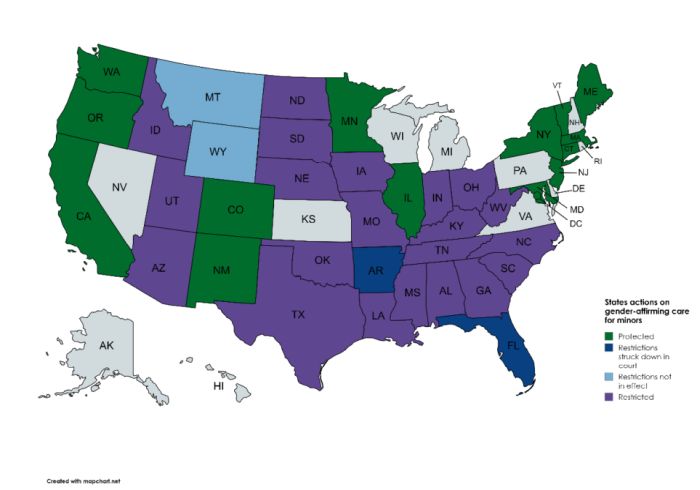On Monday, June 24, 2024, the U.S. Supreme Court agreed to review last year's Sixth Circuit decision that allowed Tennessee to keep its ban on gender-affirming care for minors in place. The Supreme Court will determine whether the Tennessee restrictions on gender-affirming care infringe on the Fourteenth Amendment rights of transgender youth for equal protection under the law.1 The Court did not act on the Biden administration's petition to review a similar case focused on Kentucky's gender-affirming care ban for minors; however, the Court's decision on the Tennessee ban will ultimately determine how the Kentucky case moves forward. The Court will begin their arguments on the Tennessee gender-affirming care ban in the fall. The decision to review the Biden administration's appeal comes at a time when 39% of transgender youth aged 13-17 are living in states that have bans on gender-affirming care.2
What is Gender-Affirming Care?
Gender-affirming care, as described by the U.S. Department of Health and Human Services (HHS), generally refers to care designed to treat gender dysphoria that may include, but is not necessarily limited to, counseling, hormone therapy, surgery, and other related services.3 Gender dysphoria, which is experienced by many transgender and non-binary people, is defined as the distress that results from having one's gender identity not match their sex assigned at birth.4 Gender-affirming care spans over a range of services including medical care, mental health care, and social services. Major national medical and mental health organizations, such as the American Medical Association and American Academy of Pediatrics, recognize that treatment of gender dysphoria is medically necessary and endorse gender-affirming care.5
What is happening at the Federal level?
On April 26, 2024, HHS, through the Office of Civil Rights (OCR), issued regulations (the "Final Rule") regarding Section 1557 of the Affordable Care Act ("Section 1557"), the nondiscrimination provision of the Affordable Care Act. The Final Rule was set to take effect July 5, 2024. In response to the Final Rule, eighteen states took part in multiple lawsuits against HHS, all claiming that the agency overstepped when creating the rule. On July 3, 2024, the Final Rule was blocked by federal judges in Mississippi, Texas, and Florida, 6,7,8 following shortly after the Supreme Court's decision to end Chevron deference.9
Section 1557 prohibits discrimination on the basis of race, color, national origin, sex, age, or disability in health programs and activities that receive federal financial assistance, involving credits, subsidies, or contracts of insurance.10 The application of Section 1557's anti-discrimination provision to gender identity has been hotly contested since Section 1557's inception. During the Obama administration, HHS promulgated the first set of regulations implementing Section 1557, which specifically stated that the discrimination on the basis of sex included discrimination based on gender identity. In 2019, during the Trump administration, this rule was challenged by religiously-affiliated healthcare providers and states and was ultimately found to be in violation of the Administrative Procedures Act and the Religious Freedom Restoration Act.11 This decision removed gender identity from the definition of sex discrimination. The remainder of the provision detailing the potential grounds for sex discrimination was eliminated by Trump-era regulations in 2020.
In 2021, under the Biden administration, HHS announced that OCR would interpret and enforce Section 1557's prohibition on sex discrimination to include gender identity and sexual orientation. In 2024, the Final Rule reinstated and strengthened many of Section 1557's protections, including by reinstating language clarifying that the law prohibits discrimination based on gender identity and specifically identifying gender-affirming care as protected under the law.
As stated in the Final Rule, under Section 1557, applicable entities cannot deny or limit services on the basis of gender identity or sex assigned at birth, adopt any policy of treating individuals differently based on sex, or deny or limit services sought for gender transition or other gender-affirming care on the basis of sex assigned at birth or gender identity.12 In response to a comment on the Final Rule, HHS stated that while Section 1557 preempts any state laws that are contrary to the Final Rule's nondiscrimination protections, OCR will consider all relevant factors in determining whether there is a legitimate nondiscriminatory reason for taking actions that conflict with Section 1557.13 HHS noted that the Final Rule will not supersede State or local laws that provide more protection against discrimination on any basis. HHS also included a religious freedom and conscience exemption for applicable entities. For more information on the Final Rule, please see here.
How have states addressed access to gender-affirming care?

Figure 1. Map of State Actions on Gender-Affirming Care for Minors.14
At the time of the Supreme Court's agreement to review the Sixth Circuit decision, half of the U.S. states have enacted laws or policies to limit minors' access to gender-affirming care (See Figure 1).15 State laws and policies on gender-affirming care vary on the types of prohibited gender-affirming care as well as specific age limitations.16 Despite most of the laws and policies being challenged in court, twenty remain in effect today. There are currently fifteen states that have taken action to protect minors' rights to access gender-affirming care.
Crowell Health Solutions will continue to track and report on new developments regarding access to gender-affirming care for minors. For more information, please contact the professionals listed below, or your regular Crowell Health Solutions contact.
Footnotes
1 Dan McKay, "High Court To Review State Gender Care Bans," Law360, June 24, 2024, https://www.law360.com/health/articles/1809482?nl_pk=5f436262-27ec-43e8-b19d6d042447c39e&utm_ source=newsletter&utm_medium=email&utm_campaign=health&utm_content=1809482&read_main=1&nlsidx=0&nlaidx=0
2 "Map: Attacks on Gender Affirming Care by State," HRC Foundation, accessed June 25, 2024, https://www.hrc.org/resources/attacks-on-gender-affirming-care-by-state-map
3. 89 FR 37522
4. "Get the Facts on Gender-Affirming Care," HRC Foundation, accessed June 25, 2024, https://www.hrc.org/resources/get-the-facts-on-gender-affirming-care
5 "Medical Organization Statements," A4TE, accessed June 25, 2024, https://transhealthproject.org/resources/medical-organization-statements/
6 See State of Tennessee, et al. v Xavier Becerra, et al., Case No. 1:24cv161-LG-BWR, U.S. District Court for the Southern District of Mississippi
7 See State of Texas, et al. v. Xavier Becerra, et al., Case No. 6:24-cv-211-JDK, U.S. District Court for the Eastern District of Texas
8 See State of Florida, et al. v. Department of Health and Human Services, et al., Case No. 8:24-cv-1080-WFJ-TGW, U.S. District Court Middle District of Florida
9 See Loper Bright Enterprises, et al. v. Raimondo, Secretary of Commerce, et al., No. 22-451, 2024 U.S. LEXIS 2882, on certiorari to the United States Court of Appeals for the District of Columbia Circuit
10. 42 U.S.C. § 18116.
11. See Franciscan Alliance, Inc. v. Azar, Case No. 414 F. Supp. 3d 928, U.S. District Court for the Northern District of Texas
12. 45 C.F.R. §§ 92.101(2) & 92.206 (as amended in the Final Rule).
13. 89 FR 37522
14. Mark Sherman, "Supreme Court will take up state bans on gender-affirming care for minors," AP News, last modified June 24, 2024, https://apnews.com/article/supreme-court-transgender-health-tennessee-kentucky-75e3b446513f61281013a2bf86248044
15 Lindsey Dawson and Jennifer Kates, "Policy Tracker: Youth Access to Gender Affirming Care and State Policy Restrictions," KFF, last modified June 24, 2024, https://www.kff.org/other/dashboard/gender-affirming-care-policy-tracker/
16 The breadth of state laws/policies prohibiting gender-affirming care for minors varies. In some states, surgical gender-affirming care for minors is prohibited, while the use of hormone or puberty blocking RX gender-affirming care is not addressed. Other state laws/policies do not allow either form of gender-affirming care for minors. There are also specific age limitations outlined in some of the state laws/policies. While most refer solely to "minors", states like Nebraska prohibit surgical gender-affirming care for individuals under the age of nineteen, which includes adults who are eighteen.
The content of this article is intended to provide a general guide to the subject matter. Specialist advice should be sought about your specific circumstances.



